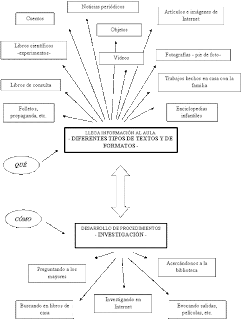Task based Activities:
According to the age and abilities of children, activities engaged during the project work are such as drawing, writing, reading, recording observations and interviewing experts. The information meeting is summarized and presented as graphic organizers, diagrams, paintings and drawings, murals, models, web publishing, PowerPoint presentations and other buildings. Classes in pre-school students, an important component of a project is a dramatic piece in which is expressed recently learned and used new vocabulary.
task based work in the curriculum of the preschool and primary education provides children with contexts in which they can apply the skills learned through the formal elements of the curriculum and those who carry out a collaborative work. It also supports the child's natural impulse to investigate his surroundings.
task based Phases:
In the first phase of a task based, which Katz and Chard (1989) called Start, children and teachers spend several periods of discussion at the selection and definition of the topic will be investigated. The topic may be proposed by a child or the teacher.
Several criteria can be considered for selecting topics. First, the topic should be closely related to children's everyday experience. Some children should have sufficient familiarity with the topic to ask questions. Second, in addition to basic reading and math, the topic should allow the integration of a variety of subjects such as science, social studies and languages. A third consideration is that the topic should be broad enough in terms of matter to be studied for at least a week. Finally, the topic should be more appropriate to study at school than at home: for example, an analysis of local insects, rather than a study of local festivals.
Once the topic has been determined, teachers begin by drawing a graphic organizer based on a spontaneous exchange of ideas such as "brainstorming" (for example, write spontaneously on the board ideas, concepts and related items). The map of the topic and related subtopics can be used later as a stimulus for further discussions as the project still in development. In preliminary discussions, the teacher and children propose the questions that attempt to answer through your research. During the first phase of the project, children also remember their own past experiences related to the topic.
The Second Phase, practical work, is the direct investigation, which often include trips to investigate sites, objects or events. In Phase II, the heart of task based work, children investigate, draw conclusions based on their observations, build models, observe carefully, record their findings, explore, predict, discuss and dramatize their new skills (Chard, 1992 .)
The Third Phase, Completing and Reporting includes the preparation and reporting of results in the form of exhibitions and artifacts, lectures, dramatic presentations or guided tours of their buildings.
Task based on the things of everyday life:
An example of a common object research environment of the child itself was a project called "All About Balls." An aunt "asked kindergarten children who put together at home, friends, relatives and others, maximum number of old balls. Then she developed a conceptual map, asking children to tell him what they would like to know about the balls. Accumulated thirty children and a ball of different kinds, including gum, a cotton, a globe, and American football (which prompted a discussion on the concepts of area, hemisphere and cone). Then the children formed subgroups to examine specific questions. One group studied the surface texture of each ball and took impressions of it to show their findings, another measured the circumference of each ball with a rope, yet another group tried to determine what the composition of each ball.
After each group to show and report its findings to classmates, the class made and tested predictions about the balls. Children and the aunt asked what the balls were the heaviest and which the lightest weight how it related to its circumference, which balls would go further on different surfaces like grass and gravel, after rolling in an inclined plane, and what would bounce higher. While the children tested their predictions, the teacher helped them explore such concepts as the weight, girth and endurance. Following this direct investigation, the children discussed the games played with balls. They discussed which balls are hit with bats, clubs, mallets, hands or feet, racquets and so on.
In short:
A project on a topic of real interest to children, such as the task based "All About Balls" described here, involves children in a variety of tasks: drawing, measuring, writing, reading, listening and discussing. When working on a task based, children learn a rich new vocabulary as their knowledge of a familiar object deepen and grow, demonstrating that they learned significantly and use the skills acquired in the classroom.






